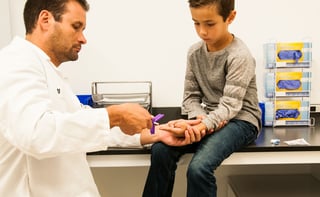Share this
how to use capillary blood samples in pediatric PK studies
by Neoteryx Microsampling on Dec 5, 2017 6:10:00 AM
 Pharmacokinetic (PK) studies investigate the absorption and movement of drugs within the body. Since children absorb and process drugs differently than adults do, PK studies have to be done on children to determine they receive safe and effective doses.
Pharmacokinetic (PK) studies investigate the absorption and movement of drugs within the body. Since children absorb and process drugs differently than adults do, PK studies have to be done on children to determine they receive safe and effective doses.
Such pediatric studies of new drugs, however, are fraught with concerns. Parents understandably do not wish for their children to be harmed or to suffer unnecessary pain because of the new drug study itself.
How PK Studies Are Conducted
PK studies used to require large volumes of blood to be collected from study participants on a routine basis. The blood samples were typically obtained via the venipuncture method, in which a phlebotomist draws blood from a vein in the arm. In children, veins are small and can be very hard to find, often requiring multiple needle pokes. This can cause significant pain and emotional trauma for both the child getting their blood drawn and their parents. Additionally, if a large volume of blood is needed for lab analysis, the child can incur a risk of anemia.
Gentler Collection of Blood Samples for Pediatric PK Studies
To avoid these blood collection challenges in pediatric studies, a technique called dried blood spot (DBS) sampling was developed. In the early 1960s, DBS was standardized for use in newborn screening for detecting genetic disorders. This innovation introduced the concept of a quick heel-stick with a lancet to draw a few drops of blood via microsampling. The "micro-sized" blood drops placed on filter paper could be used to replace the more invasive venipuncture blood draws for certain lab tests.
While the standard DBS method is gentler and more convenient, it has its challenges. The hematocrit in the blood affects the amount that is absorbed onto the DBS filter paper. This results in irregular amounts of drugs contained within the DBS samples, which can skew lab results. For this reason, standard DBS is not always suitable in PK studies.
Volumetric Microsampling for PK Studies
/hemaPEN%20images%20for%20Review/WEB/about-collect-hemaPEN-clinic-setting_4%20copy.jpg?width=525&height=359&name=about-collect-hemaPEN-clinic-setting_4%20copy.jpg) Volumetric microsampling is a more recent blood sampling method that was developed as an advance over standard DBS for use in situations where consistent and precise sample size is critical. The hemaPEN® is a volumetric microsampling device that uses the finger-stick method to collect four volumetrically identical capillary samples.
Volumetric microsampling is a more recent blood sampling method that was developed as an advance over standard DBS for use in situations where consistent and precise sample size is critical. The hemaPEN® is a volumetric microsampling device that uses the finger-stick method to collect four volumetrically identical capillary samples.
After a single finger-stick with a lancet, the hemaPEN is placed directly onto the blood drop that forms at the fingertip. The blood is wicked up inside the device via its four glass capillary tubes and then transferred onto its four DBS filter papers inside. The four DBS filter papers in the device are pre-punched and are sized to absorb precisely 2.74 µL for each DBS sample. Thus, a single sampling event produces 4 x 2.74 µL DBS samples, for a total volume of 10.96 µL ready for reliable lab analysis.
Volumetric Absorptive Microsampling for PK Studies
There also is a technique called volumetric absorptive microsampling where the blood from a finger-stick or heel-stick is absorbed onto an absorbent sponge tip with volumetric precision.
/lightbox-universal-solo-2-xtr-brit.jpg?width=497&height=333&name=lightbox-universal-solo-2-xtr-brit.jpg) The Neoteryx Mitra® device based on VAMS® technology is available with three different sizes of an absorbent VAMS tip, which can be dipped into whole blood (or plasma, urine, saliva, etc.) to absorb between 5 and 30 microliters.
The Neoteryx Mitra® device based on VAMS® technology is available with three different sizes of an absorbent VAMS tip, which can be dipped into whole blood (or plasma, urine, saliva, etc.) to absorb between 5 and 30 microliters.
This precision eliminates the problem of hematocrit bias, as demonstrated in multiple studies. After sample collection, the sampled devices are air dried and can be stored at room temperature.
Centrifugation is not required with the VAMS method, which saves process steps and time in a PK Study. A supernatant liquid is then added, and the samples are analyzed on a mass spectrometer for the drug levels.
As with animal studies that are part of preclinical research, the use of microsampling with capillary blood samples saves time and money during pediatric PK studies as well as decreasing pain and anxiety in children. In the world of pediatric PK studies, microsampling provides a "less is more" solution.
Image credits: Trajan, Neoteryx
Share this
- Microsampling (206)
- Research, Remote Research (119)
- Venipuncture Alternative (105)
- Clinical Trials, Clinical Research (83)
- Mitra® Device (73)
- Therapeutic Drug Monitoring, TDM (51)
- Dried Blood Spot, DBS (39)
- Biomonitoring, Health, Wellness (30)
- Infectious Disease, Vaccines, COVID-19 (24)
- Blood Microsampling, Serology (23)
- Omics, Multi-Omics (21)
- Decentralized Clinical Trial (DCT) (20)
- Specimen Collection (18)
- Toxicology, Doping, Drug/Alcohol Monitoring, PEth (17)
- Skin Microsampling, Microbiopsy (14)
- hemaPEN® Device (13)
- Preclinical Research, Animal Studies (12)
- Pharmaceuticals, Drug Development (9)
- Harpera Device (7)
- Industry News, Microsampling News (5)
- Antibodies, MAbs (3)
- Company Press Release, Product Press Release (3)
- Environmental Toxins, Exposures (1)
- July 2025 (1)
- May 2025 (1)
- April 2025 (2)
- December 2024 (2)
- November 2024 (1)
- October 2024 (3)
- September 2024 (1)
- June 2024 (1)
- May 2024 (1)
- April 2024 (4)
- March 2024 (1)
- February 2024 (2)
- January 2024 (4)
- December 2023 (3)
- November 2023 (3)
- October 2023 (3)
- September 2023 (3)
- July 2023 (3)
- June 2023 (2)
- April 2023 (2)
- March 2023 (2)
- February 2023 (2)
- January 2023 (3)
- December 2022 (2)
- November 2022 (3)
- October 2022 (4)
- September 2022 (3)
- August 2022 (5)
- July 2022 (2)
- June 2022 (2)
- May 2022 (4)
- April 2022 (3)
- March 2022 (3)
- February 2022 (4)
- January 2022 (5)
- December 2021 (3)
- November 2021 (5)
- October 2021 (3)
- September 2021 (3)
- August 2021 (4)
- July 2021 (4)
- June 2021 (4)
- May 2021 (4)
- April 2021 (3)
- March 2021 (5)
- February 2021 (4)
- January 2021 (4)
- December 2020 (3)
- November 2020 (5)
- October 2020 (4)
- September 2020 (3)
- August 2020 (3)
- July 2020 (6)
- June 2020 (4)
- May 2020 (4)
- April 2020 (3)
- March 2020 (6)
- February 2020 (3)
- January 2020 (4)
- December 2019 (5)
- November 2019 (4)
- October 2019 (2)
- September 2019 (4)
- August 2019 (4)
- July 2019 (3)
- June 2019 (7)
- May 2019 (6)
- April 2019 (5)
- March 2019 (6)
- February 2019 (5)
- January 2019 (8)
- December 2018 (3)
- November 2018 (4)
- October 2018 (7)
- September 2018 (6)
- August 2018 (5)
- July 2018 (8)
- June 2018 (6)
- May 2018 (5)
- April 2018 (6)
- March 2018 (4)
- February 2018 (6)
- January 2018 (4)
- December 2017 (2)
- November 2017 (3)
- October 2017 (2)
- September 2017 (4)
- August 2017 (2)
- July 2017 (4)
- June 2017 (5)
- May 2017 (6)
- April 2017 (6)
- March 2017 (5)
- February 2017 (4)
- January 2017 (1)
- July 2016 (3)
- May 2016 (1)
- April 2016 (2)



Comments (1)